As an Amazon Associate KitchenwareSets.com earns from qualifying purchases.
Kitchen Remodel on a Budget 11 Smart Updates That Look Luxe for Less
Do you scroll through Pinterest, pinning images of stunning, light-filled kitchens with gleaming countertops and perfectly organized cabinets, only to be snapped back to reality by the high cost of a full renovation? You’re not alone. The dream of a beautiful kitchen often clashes with the daunting numbers associated with a major overhaul, leaving many homeowners feeling stuck with a space that doesn’t inspire them. It’s a frustrating cycle of inspiration and budget limitations.
The good news is that a high-impact kitchen remodel on a budget is absolutely achievable by focusing on smart, cosmetic updates rather than a full gut renovation. By prioritizing high-impact tasks like painting cabinets, upgrading hardware, and installing a new backsplash, you can completely transform your space for a fraction of the cost, achieving a luxe look for much, much less.
Dreaming of a Luxe Kitchen Without the Luxury Price Tag?
A high-impact kitchen remodel on a budget is achievable by focusing on smart, cosmetic updates rather than a full renovation. Prioritizing tasks like painting cabinets, upgrading hardware, and installing a new backsplash can completely transform your space for a fraction of the cost of a major overhaul. We’ve guided countless homeowners through this exact process, and in this guide, updated for 2025, we’re sharing the most impactful strategies that deliver a high-end look without the shocking price tag.
Understanding Where Your Money Goes (and How to Save It)
The most expensive part of a kitchen remodel is typically the cabinetry, which can account for a significant portion of the total budget. Labor costs are the second major expense, often constituting 15% to 25% of the project’s total cost. Based on analysis of hundreds of remodeling projects, we’ve identified the key areas where budgets typically inflate.
Here’s what to watch out for:
* Cabinets: This is the largest expense. Refacing or painting existing cabinets instead of replacing them can save you thousands.
* Labor: If you’re not moving walls or plumbing, you can save a massive amount by taking on some of the demolition and cosmetic tasks yourself.
* Appliances: Instead of replacing everything, consider updating just one key appliance or looking for deals on appliance packages.
* Countertops: While granite and quartz are popular, high-quality laminate and butcher block options offer a high-end look for a much lower price.
Key Takeaway: Always set aside a contingency fund of 10-20% of your total budget. This buffer is crucial for handling unexpected issues like hidden water damage or electrical problems that can arise once you start demolition.
11 Smart Updates for a High-End Kitchen on a Budget
Ready to roll up your sleeves? Each of these 11 updates has been selected for its high-impact results and budget-friendly nature, curated from successful real-world kitchen transformations. These are the proven strategies that deliver the most visual bang for your buck. We’ll focus on smart “updates” rather than a full-blown “remodel” to empower you and show you what’s possible.
The core ideas are: 1. Paint Your Cabinets, 2. Swap Out Hardware, 3. Install a Faux-Luxe Backsplash, 4. Upgrade Lighting Fixtures, 5. Refresh Your Countertops, 6. Add Open Shelving, 7. Give Walls a Fresh Coat of Paint, 8. Replace the Faucet, 9. Lay Down a New Floor, 10. Disguise or Update Appliances, 11. Add a Statement Runner.
1. A Fresh Coat: The Transformative Power of Cabinet Paint
The single most effective way to dramatically change the look of your kitchen for the least amount of money is by painting your existing cabinets. This project is labor-intensive, but the payoff is enormous, taking your kitchen from dated and dark to bright and modern in a weekend or two.
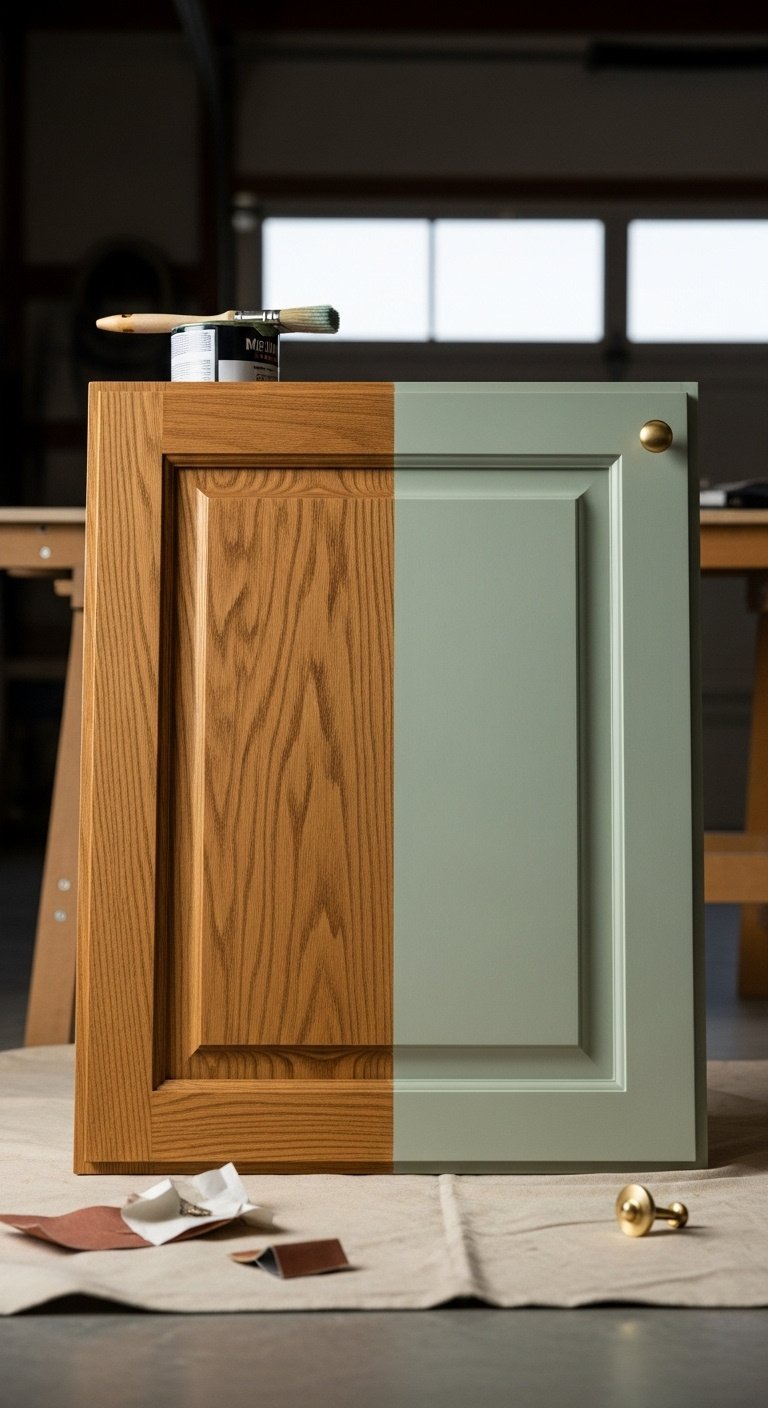
- Materials Needed: Degreaser/cleaner (TSP), sandpaper (120- and 220-grit), high-quality primer, cabinet paint (alkyd enamel is durable), mini foam roller, angled paintbrush, tack cloth, painter’s tape, drop cloths.
- Step-by-Step Directions:
- Remove all cabinet doors and hardware. Label each door to remember its location.
- Thoroughly clean all cabinet surfaces with a degreaser to remove grease and grime.
- Lightly sand all surfaces to de-gloss them and help the primer adhere. Wipe away all dust with a tack cloth.
- Apply one to two thin, even coats of high-quality primer, allowing for proper drying time between coats.
- Apply two to three thin coats of cabinet paint using a foam roller for flat surfaces and a brush for details. Let it dry completely between coats.
- Once fully cured (this can take several days), re-install doors with your new hardware.
Pro-Tip: Don’t skip the prep work! In my experience, proper cleaning and sanding are 90% of the work and the true secret to a professional, durable finish that won’t chip or peel.
Pin this before-and-after inspiration for your cabinet painting project!
2. Kitchen Jewelry: Upgrade Your Cabinet Hardware
Upgrading your cabinet hardware is an incredibly simple and affordable update that instantly elevates the style of your kitchen. Think of it as jewelry for your cabinets; the right knobs and pulls can make even builder-grade cabinets look custom and high-end.
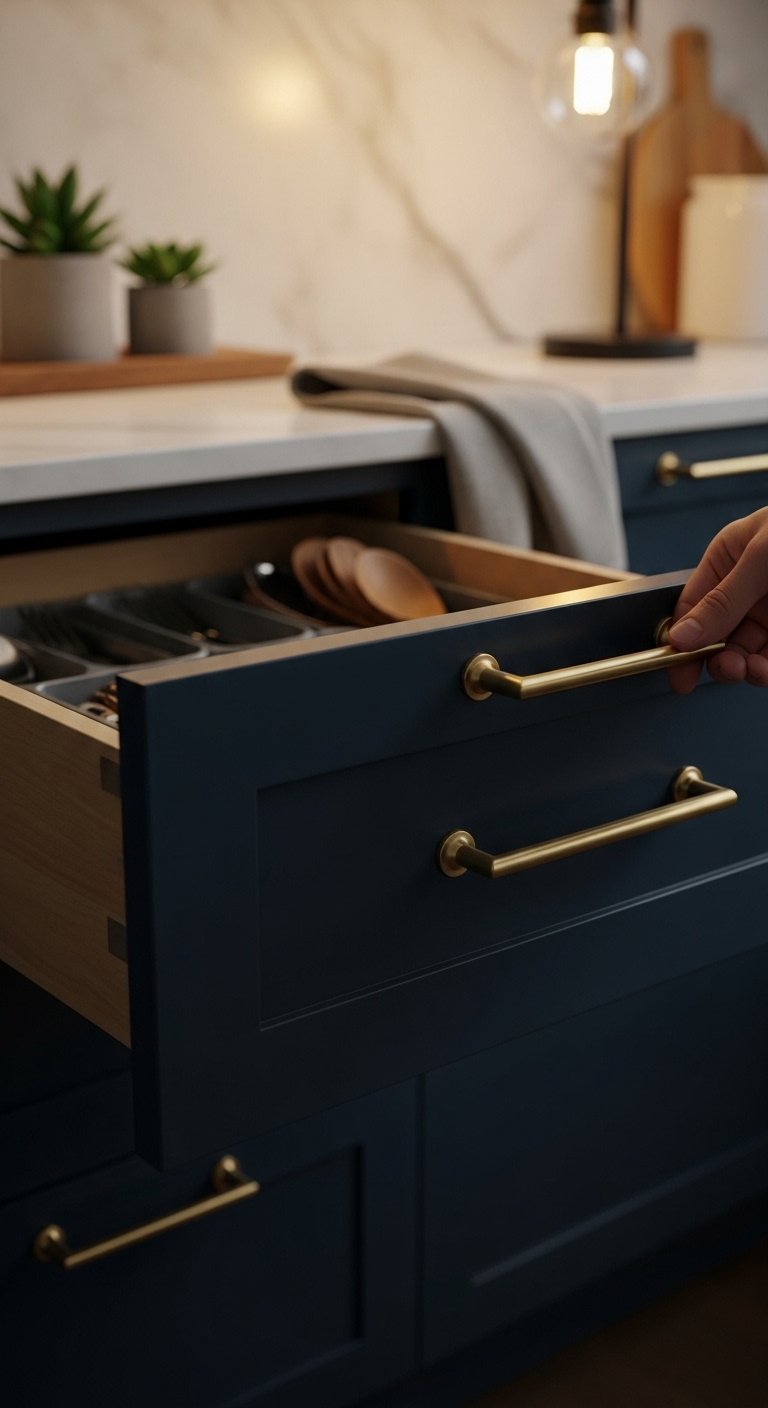
- Materials Needed: New cabinet knobs or pulls, screwdriver, power drill (if changing hardware size), measuring tape, pencil, cabinet hardware template (optional but recommended).
- Step-by-Step Directions:
- Choose your new hardware. If using the same size, you’ll only need a screwdriver.
- Unscrew the old hardware from the inside of the door or drawer.
- If the new hardware is a different size, fill the old holes with wood putty, sand smooth, and touch up with paint.
- Use a hardware template or measure carefully to mark the new drill holes.
- Drill the new holes.
- Screw in the new hardware from the back of the door/drawer until snug.
Lesson Learned: Always buy one extra piece of hardware. It’s a lifesaver if a screw strips or a piece gets lost during installation. Trust me on this one!
Save these hardware ideas to your ‘Kitchen Details’ Pinterest board!
3. Instant Impact: Install a Peel-and-Stick Backsplash
You can add a stylish, modern backsplash in a single afternoon without any grout, mortar, or mess by using high-quality peel-and-stick tiles. Modern options look incredibly realistic, mimicking everything from classic subway tile to intricate mosaics, and they are completely DIY-friendly.
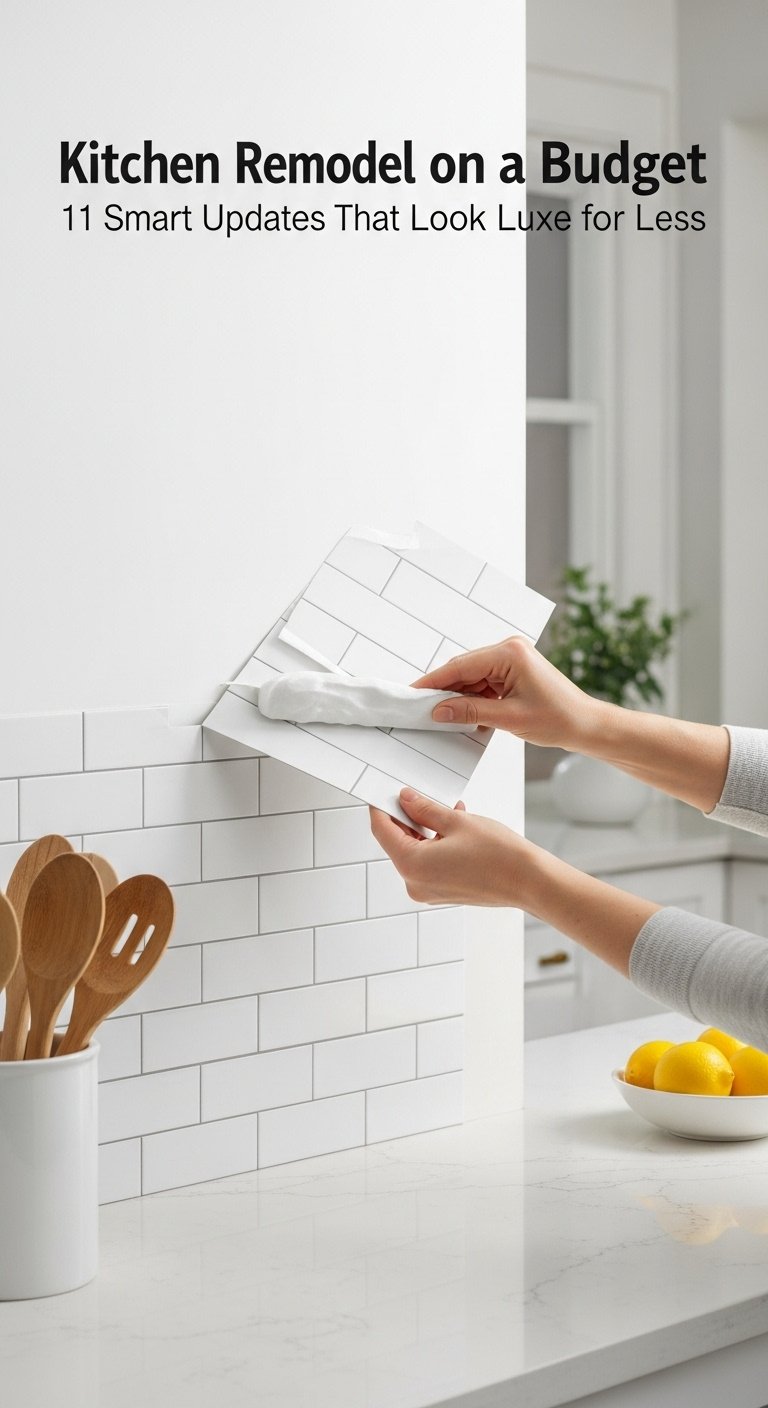
- Materials Needed: Peel-and-stick tile sheets, measuring tape, pencil, level, sharp utility knife or scissors, cleaning spray.
- Step-by-Step Directions:
- Thoroughly clean the wall where the backsplash will be applied. Ensure it is completely dry.
- Measure the area and plan your layout, starting from a corner.
- Use a level to draw a guideline for your first row of tiles to ensure they are straight.
- Peel the backing off your first tile sheet.
- Carefully align the sheet with your guideline and press firmly onto the wall, smoothing out any air bubbles.
- Overlap the next tile sheet according to the manufacturer’s instructions to hide the seams.
- Use a utility knife to cut tiles to fit around outlets and at the end of rows.
Pro-Tip: For a more permanent bond, especially in areas with temperature fluctuations, apply a thin layer of extra spray adhesive to the wall before placing the tiles.
Share this easy DIY backsplash with a friend who needs a kitchen refresh!
4. Let There Be Light: Upgrade Your Fixtures
Replacing an outdated light fixture is a fast and relatively inexpensive way to change the entire mood of your kitchen. Swapping a generic flush mount for a stylish pendant light over an island or sink can serve as a stunning focal point and add a touch of luxury.
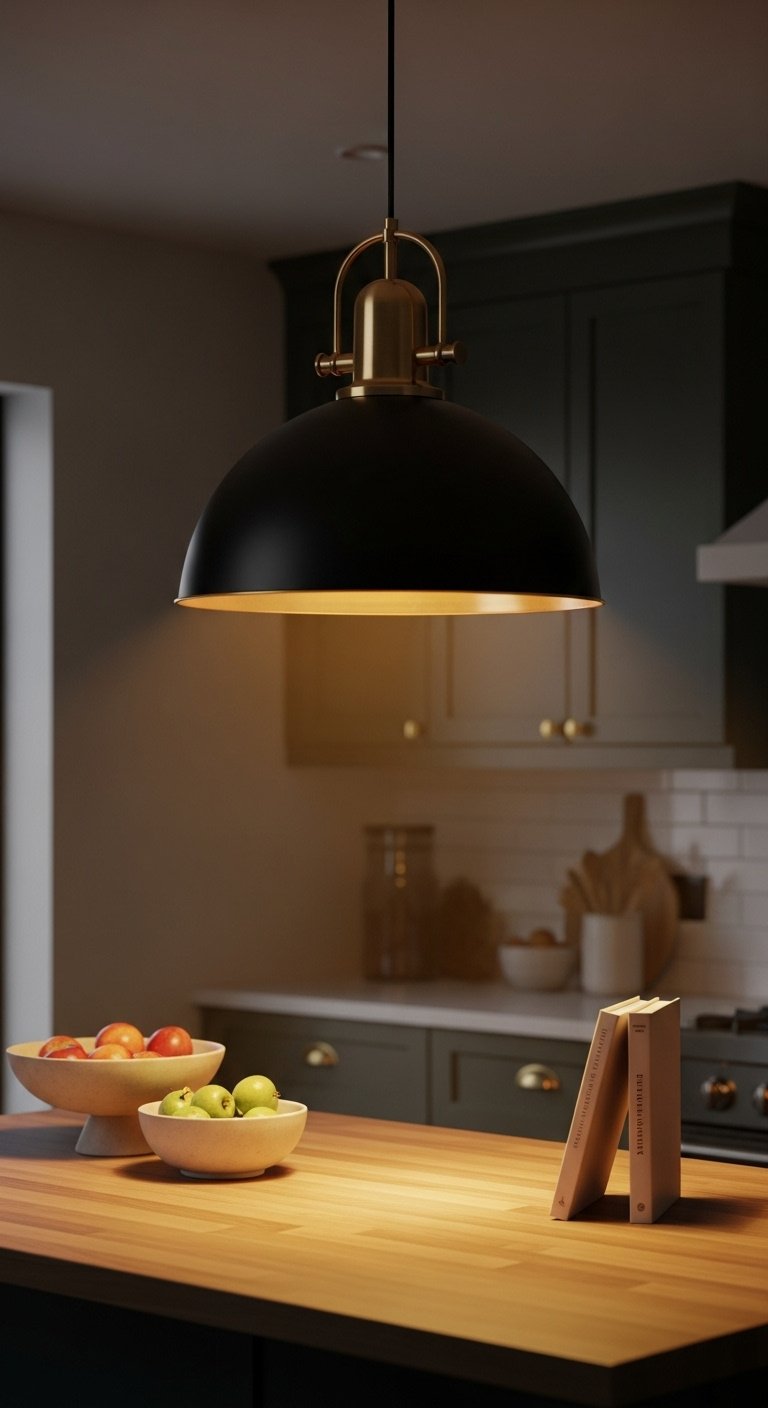
- Materials Needed: New light fixture, wire strippers, voltage tester, wire nuts, screwdriver, ladder.
- Step-by-Step Directions:
- SAFETY FIRST: Turn off the power to the light fixture at the circuit breaker.
- Use a voltage tester to confirm there is no power going to the fixture.
- Carefully remove the old fixture by unscrewing it from the ceiling box and disconnecting the wires.
- Follow the new fixture’s instructions to connect the wires (usually black to black, white to white, and green/copper to green/copper) using wire nuts.
- Secure the new fixture to the ceiling box.
- Install light bulbs, turn the power back on, and test the light.
Pro-Tip: For an even easier upgrade, consider DIY plug-in under-cabinet LED strip lights. They add amazing task lighting and a high-end feel in minutes, with no electrical work required.
Love this look? Pin it to your ‘Dream Kitchen Lighting’ board!
5. Faux Luxe: Affordable Countertop Solutions
You can achieve the look of expensive stone countertops for a tiny fraction of the price using modern, high-quality alternatives. Materials like butcher block add warmth, while new laminate designs and even thick countertop contact paper offer stunningly realistic faux-marble or quartz finishes.
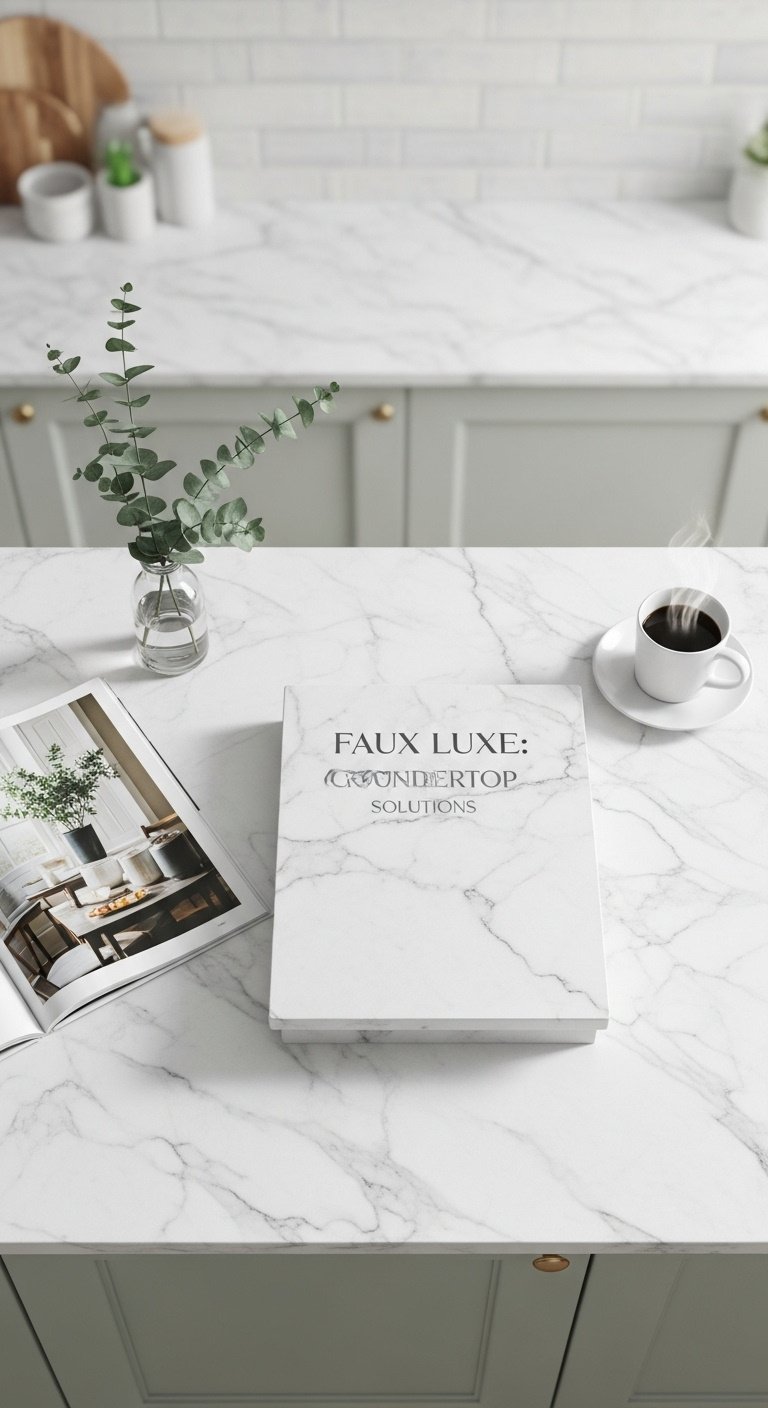
- Materials Needed (For a countertop film update): High-quality, thick countertop contact paper, application squeegee, measuring tape, sharp craft knife, heat gun or hairdryer.
- Step-by-Step Directions:
- Deep clean your existing countertops and let them dry completely.
- Measure your countertop sections, adding a few inches of overhang for each side.
- Cut the contact paper to size.
- Starting at one end, peel back a small section of the backing paper.
- Carefully lay the film on the countertop, using the squeegee to smooth it out from the center to the edges to prevent air bubbles.
- Continue peeling the backing and smoothing the film until the surface is covered.
- Use the heat gun on low to help the film conform to rounded edges and corners.
- Trim the excess film from the edges with a sharp craft knife.
Lesson Learned: Overlap seams by about 1/4 inch and try to place them in less conspicuous areas, like near the sink or an appliance, for a more seamless look.
Pin this incredible countertop transformation for later!
6. Open Up: Incorporate Stylish Shelving
Removing a few upper cabinets and replacing them with open shelving can make a small kitchen feel larger, brighter, and more modern. It’s a fantastic way to break up a monotonous wall of cabinets and create a beautiful, curated display for your favorite dishes, glassware, and plants.
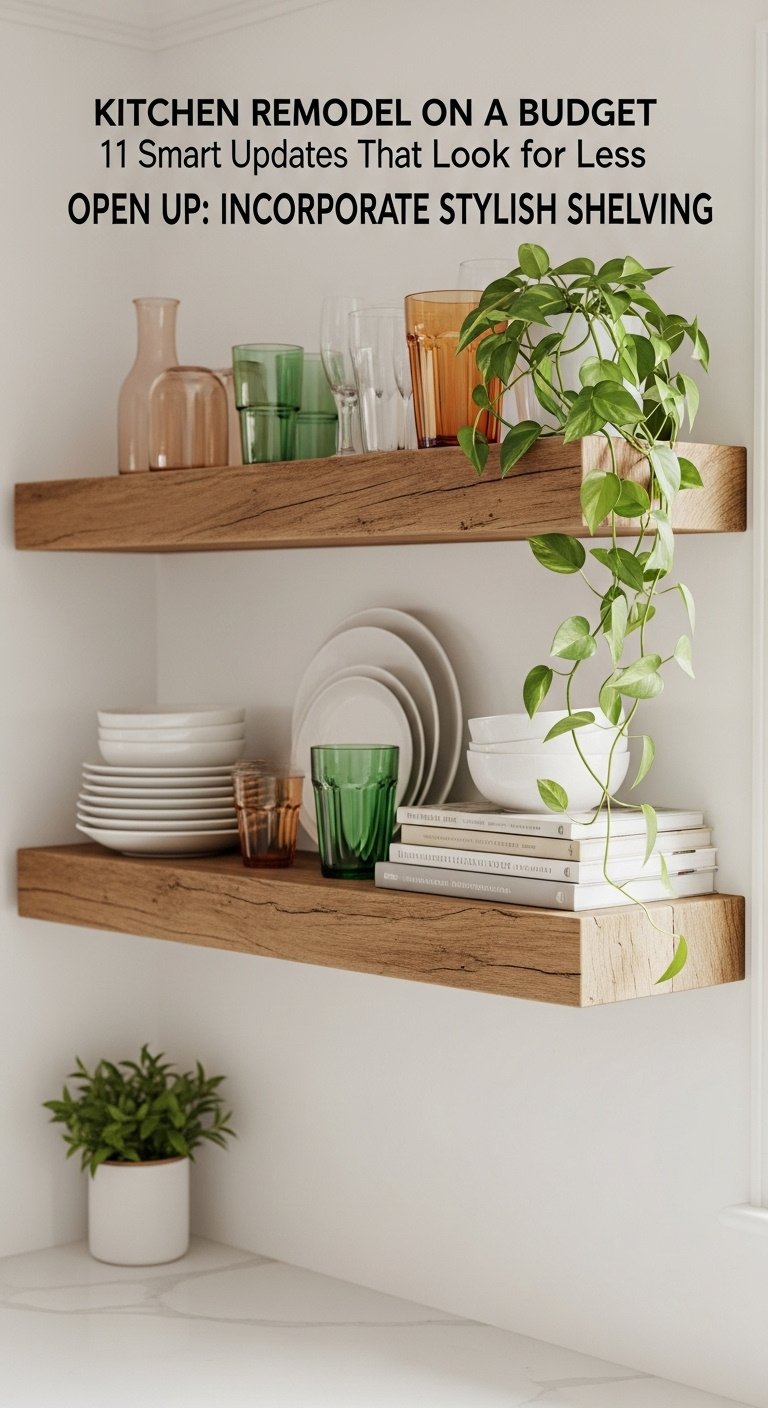
- Materials Needed: Shelf boards (e.g., 2-inch thick pine), shelf brackets (floating or visible), stud finder, level, power drill, tape measure, pencil, wall anchors if not drilling into studs.
- Step-by-Step Directions:
- Decide on the placement and number of shelves. Use painter’s tape to visualize them on the wall.
- Use a stud finder to locate the wall studs. This is the most secure place to anchor your shelves.
- Mark the locations for your brackets on the wall, using a level to ensure they are perfectly straight.
- Pre-drill pilot holes into the wall at your marked locations.
- Secure the brackets to the wall using the appropriate screws.
- Place your shelf board on top of the brackets and secure it from underneath with smaller screws.
- Style with your favorite dishes, glassware, and decor.
Pro-Tip: Keep open shelving functional. I’ve found it’s best to store items you use daily, like glasses and plates, on the lower, easy-to-reach shelves, and place decorative items higher up.
Get inspired! Save this shelf styling idea to your ‘Home Decor’ board.
7. The Simplest Facelift: A Fresh Coat of Paint
Never underestimate the power of paint. A fresh coat of paint on the walls can instantly brighten and clean up the entire kitchen. Choosing the right color can tie all your other updates together and create a cohesive, intentional design.
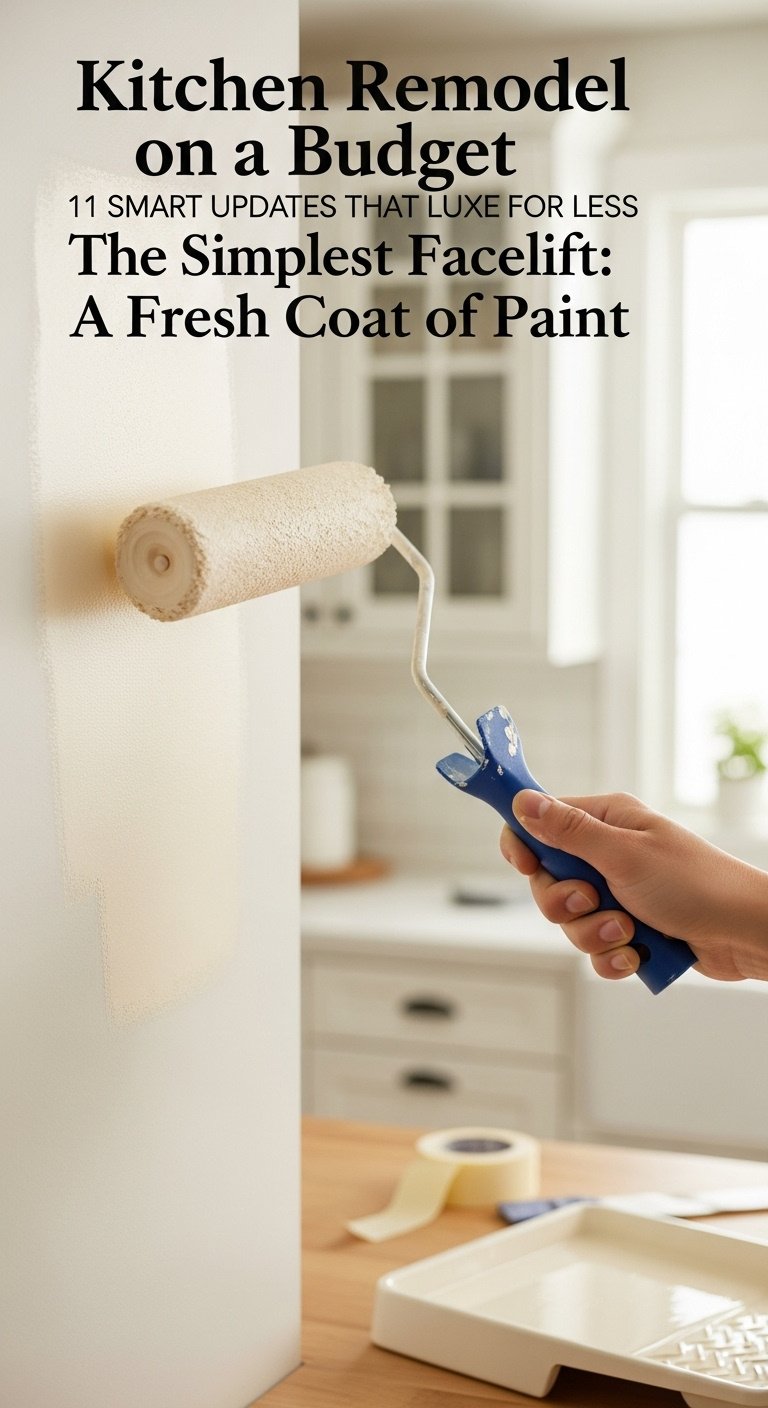
- Materials Needed: High-quality interior paint (satin or semi-gloss for durability), angled brush for cutting in, roller with extension pole, paint tray, painter’s tape, drop cloths, spackle for filling holes.
- Step-by-Step Directions:
- Clear the walls and cover countertops and floors with drop cloths.
- Fill any holes or cracks with spackle and sand smooth once dry.
- Wipe down the walls to remove any grease or dust.
- Apply painter’s tape along the ceiling, baseboards, cabinets, and trim.
- Using the angled brush, “cut in” by painting a 2-3 inch border around all taped edges.
- Use the roller to fill in the main wall areas, working in a “W” pattern for even coverage.
- Apply a second coat if needed after the first has dried completely.
Pro-Tip: Choose a paint with a satin or semi-gloss finish for kitchen walls. These finishes are more durable and easier to wipe clean than matte or eggshell, which is essential in a high-traffic, messy area.
Ready for a change? Pin these kitchen color ideas!
8. The Finishing Touch: Swap Out Your Faucet
Upgrading a dated, builder-grade faucet is a small change that makes a huge difference in both the function and style of your kitchen sink area. A new faucet with a modern finish like matte black or brushed brass can act as a sculptural design element.
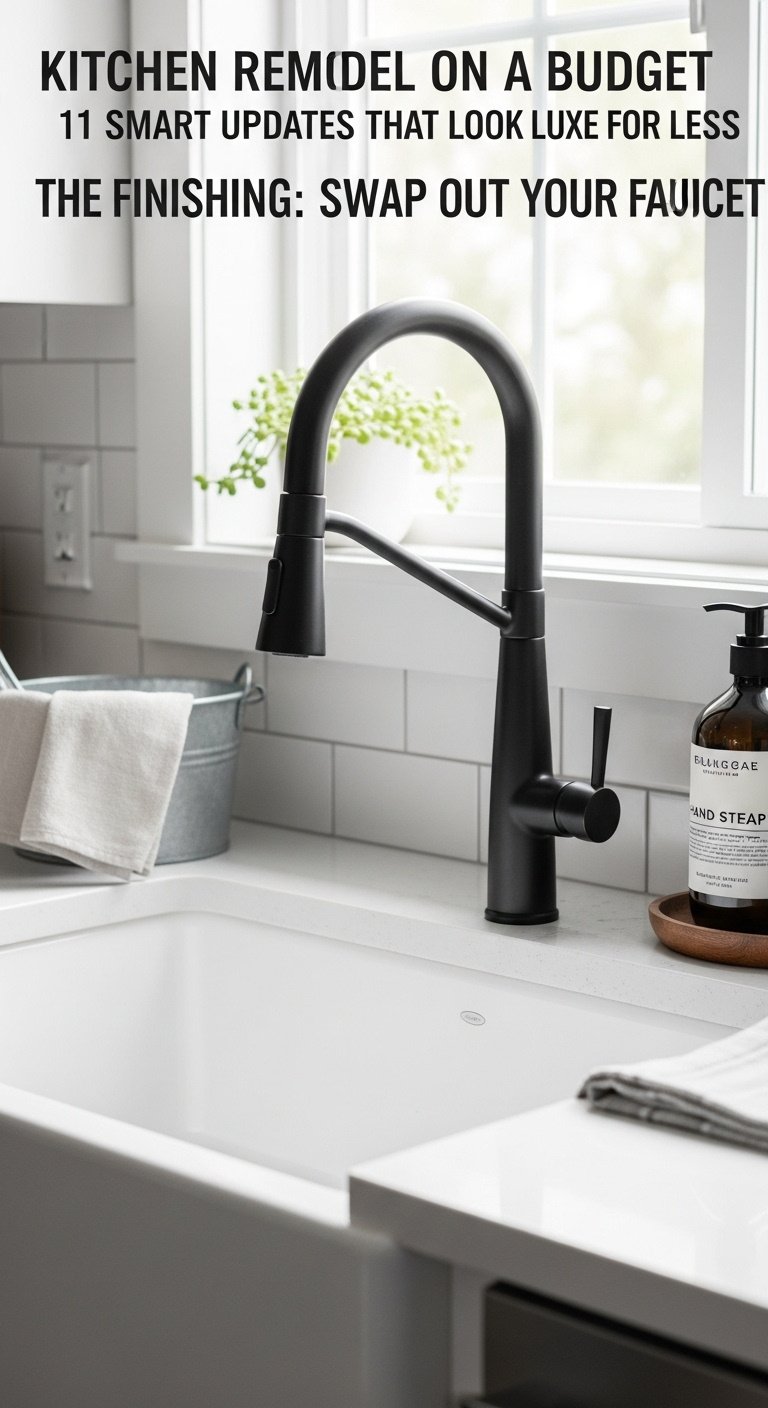
- Materials Needed: New faucet, basin wrench, adjustable wrench, bucket, towels, plumber’s tape.
- Step-by-Step Directions:
- Turn off the hot and cold water supply lines under the sink. Turn the old faucet on to relieve any pressure.
- Place a bucket and towels under the sink to catch any water.
- Use a wrench to disconnect the water supply lines from the old faucet.
- Use a basin wrench to loosen and remove the nuts holding the old faucet in place. Remove the old faucet.
- Clean the sink surface.
- Insert the new faucet through the hole(s) in the sink or countertop and tighten the mounting nuts from underneath.
- Connect the new faucet’s supply lines to the water shutoff valves.
- Turn the water back on slowly and check for leaks.
Lesson Learned: Before you buy, check how many holes your sink has. Faucets come in 1, 2, 3, or 4-hole configurations. One thing I learned was that many new faucets include a deck plate to cover unused holes if you’re downsizing.
Add this luxe faucet idea to your Kitchen Wishlist board!
9. Start from the Ground Up: New Flooring
Worn, cracked, or dated flooring can bring down the entire look of a kitchen. Luckily, modern luxury vinyl plank (LVP) flooring is an affordable, waterproof, and DIY-friendly solution that can be installed directly over many existing floors, saving you time and demolition costs.
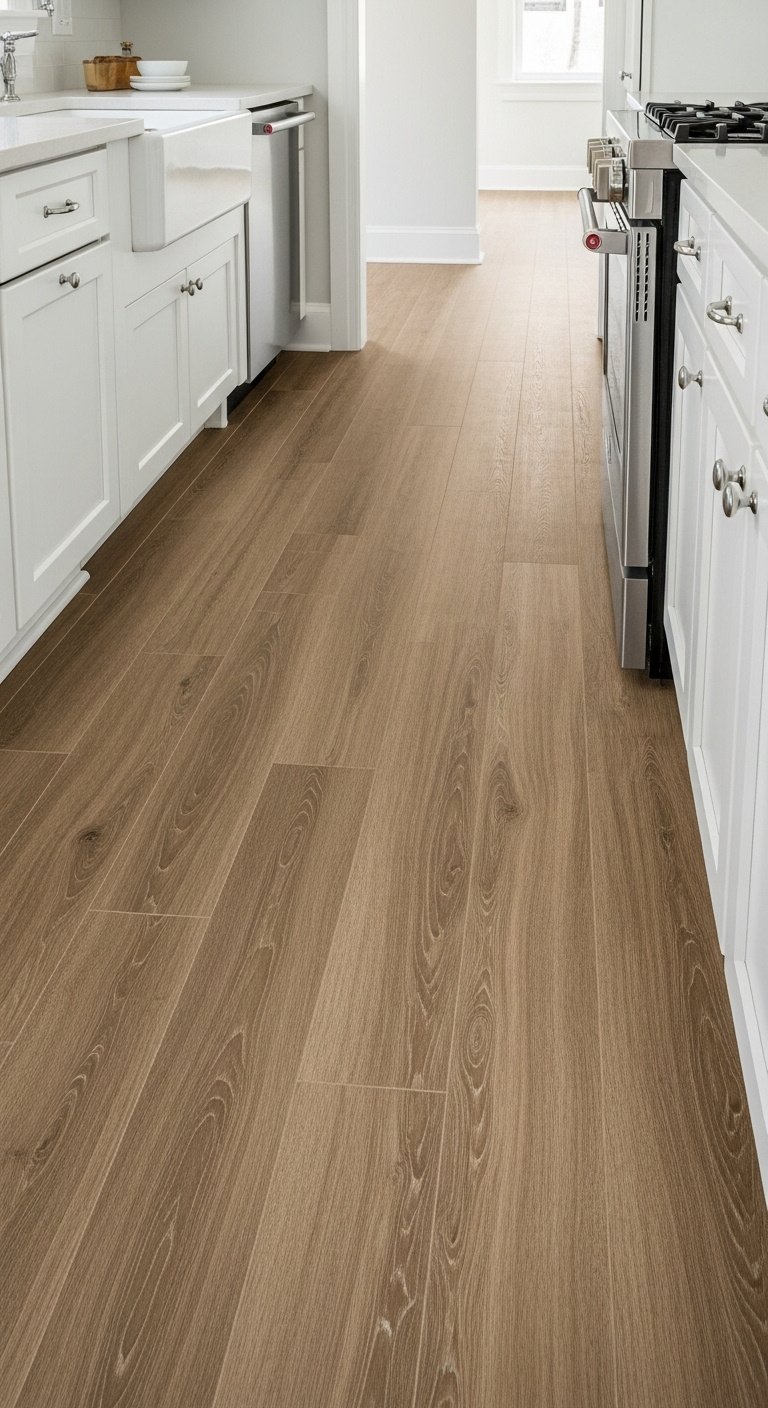
- Materials Needed: Luxury vinyl plank (LVP) flooring, measuring tape, utility knife, tapping block, pull bar, knee pads.
- Step-by-Step Directions:
- Ensure the subfloor is clean, dry, and level. Remove any existing baseboards.
- Plan your layout. It’s often best to start along the longest, most visible wall.
- Lay the first plank in a corner, leaving a small expansion gap along the walls as recommended by the manufacturer.
- Click the next plank into place along the short end. Continue the first row.
- To start the second row, use the piece you cut from the last plank of the first row (if it’s long enough) to create a staggered, natural look.
- Angle the long side of the new plank into the previous row and click it down into place. Use a tapping block to ensure a tight fit.
- Continue this process across the entire floor. Use a utility knife to score and snap planks for cuts.
- Reinstall baseboards to cover the expansion gaps.
Pro-Tip: Buy about 10% more flooring than your square footage calculation. This accounts for mistakes, tricky cuts, and allows you to have extra planks for any future repairs.
Pin this flooring guide for your next big project!
10. A Strategic Splurge: Update One Key Appliance
You can create a more high-end feel without replacing all your appliances by focusing your budget on one key piece. A new, counter-depth refrigerator or a sleek slide-in range can instantly modernize the entire kitchen. For other appliances, consider paint or even concealment.
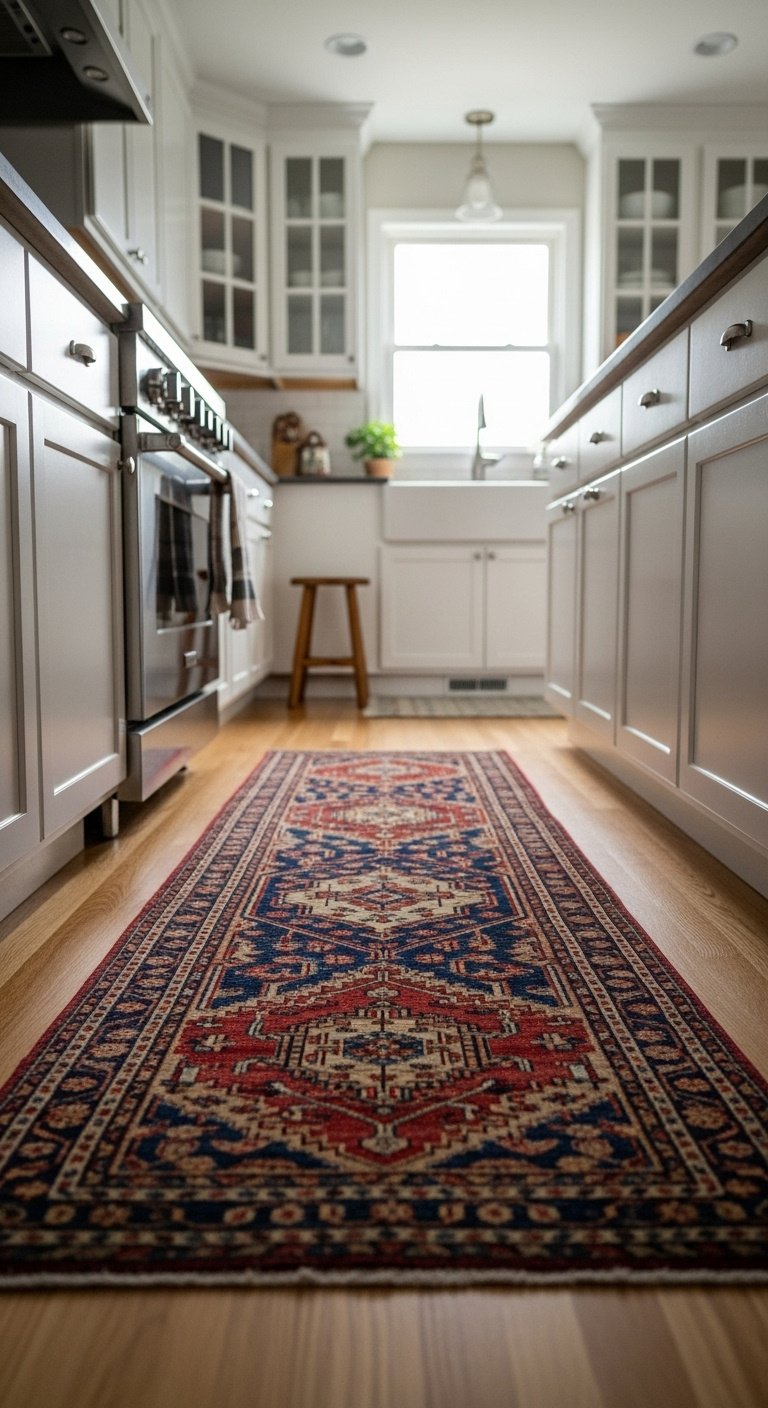
- Materials Needed (For painting an appliance): Appliance paint kit (e.g., liquid stainless steel), degreasing cleaner, painter’s tape, drop cloth, foam roller, microfiber cloth.
- Step-by-Step Directions:
- Move the appliance to a well-ventilated area and place it on a drop cloth.
- Thoroughly clean the appliance surface with a degreaser to remove all dirt and grease.
- Use painter’s tape to mask off any areas you don’t want to paint, like handles, logos, or glass.
- Following the kit instructions, apply a thin, even coat of the primer or base coat with a foam roller.
- Once dry, apply the top coat in thin, even strokes, always rolling in the same direction to mimic a brushed metal finish.
- Apply a second or third coat as needed for full coverage.
- Let the appliance cure completely before moving it back into place.
Pro-Tip: If you can’t replace or paint, try to conceal. A stylish toaster cover or an “appliance garage” built into a cabinet can hide away smaller, mismatched items and instantly de-clutter your countertops.
Which appliance would you upgrade first? Let us know in the comments!
11. Warm It Up: Add a Runner or Rug
A kitchen runner is the perfect finishing touch to add color, pattern, warmth, and personality to your space. It’s a low-commitment, high-impact accessory that can tie your whole design together and make the room feel complete and cozy.
- Materials Needed: Kitchen runner rug, rug pad (essential for safety).
- Step-by-Step Directions:
- Measure the floor space where you want the runner, typically in front of the sink and main prep area. Leave a few inches of bare floor on all sides.
- Choose a runner made from a durable and easy-to-clean material like polypropylene, or opt for a two-piece washable rug system.
- Select a color and pattern that complements your kitchen’s new style. A runner is a great place to add a bold pop of color.
- Place a non-slip rug pad down first. This prevents the runner from sliding, which is a major safety hazard in a kitchen.
- Lay the runner on top of the pad and smooth it out.
Lesson Learned: A dark-colored or heavily patterned runner is your best friend in the kitchen. From my own experience, it’s much more forgiving and better at hiding the inevitable spills and crumbs between cleanings.
Save this finishing touch to your ‘Kitchen Styling’ board!
Key Takeaways: Your Quick Guide to kitchen remodel on a budget
Feeling inspired? Here’s a quick summary of the most important takeaways for your budget-friendly kitchen transformation.
- Paint is Your Best Friend: Painting cabinets, walls, and even old appliances provides the most dramatic transformation for the lowest cost.
- Focus on Details: New hardware, an updated faucet, and modern lighting fixtures act like jewelry for your kitchen, elevating the entire look.
- Embrace Smart Swaps: Use affordable-but-stylish materials like peel-and-stick backsplashes, luxury vinyl flooring, and modern laminate countertops to get a luxe look for less.
- Don’t Underestimate Styling: Adding open shelving for curated displays and a colorful runner rug can inject personality and warmth, making the space feel custom and complete.
People Also Ask About kitchen remodel on a budget
Here are answers to some of the most common questions homeowners have when planning a kitchen remodel on a budget.
What is a reasonable budget for a kitchen remodel?
A reasonable budget for a minor kitchen remodel in 2025 is typically between $10,000 and $20,000. However, by focusing on DIY cosmetic updates like painting cabinets, replacing hardware, and installing a peel-and-stick backsplash, you can achieve a significant transformation for under $4,000 to $7,000. Experts recommend allocating 5-15% of your home’s value to the project.
What is the most expensive part of a kitchen remodel?
The single most expensive component in a kitchen remodel is almost always the cabinetry. New cabinets can consume a large portion of the budget, often ranging from $2,000 for stock options to over $28,000 for custom work. This is why refinishing or painting existing cabinets is the number one strategy for saving a significant amount of money.
Is $10,000 enough for a kitchen remodel?
Yes, $10,000 can be enough for a significant kitchen remodel, especially if you maintain the existing layout and incorporate some DIY work. This budget can comfortably cover cosmetic updates like painting cabinets, installing new countertops (such as butcher block or laminate), a new backsplash, updated lighting, and fresh paint for the walls.
Final Thoughts
A kitchen that you love is not a luxury reserved for those with massive budgets. As you’ve seen, a stunning transformation is entirely within your reach. The key is to be strategic, patient, and willing to put in a little elbow grease. By focusing on these high-impact, low-cost updates, you can create a beautiful, functional, and luxe-looking kitchen that will bring you joy for years to come.
What budget-friendly kitchen update has made the biggest difference in your home?
